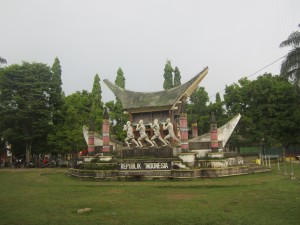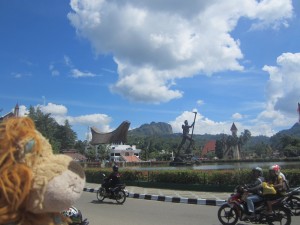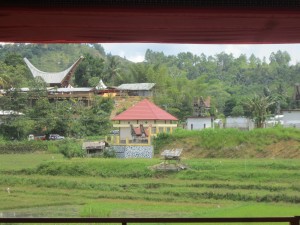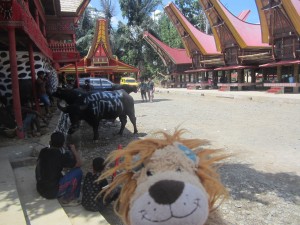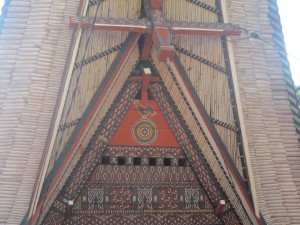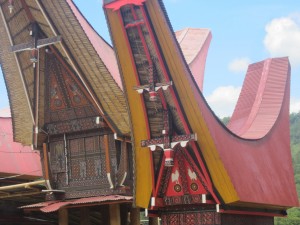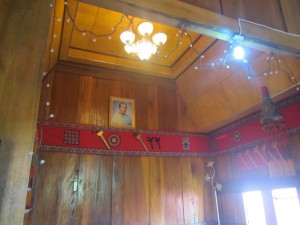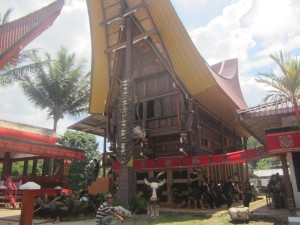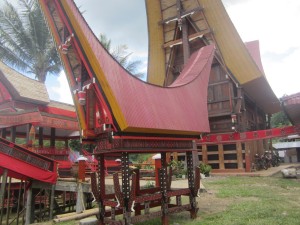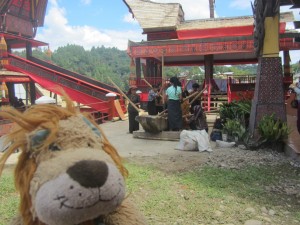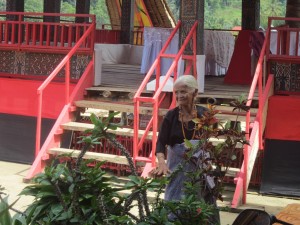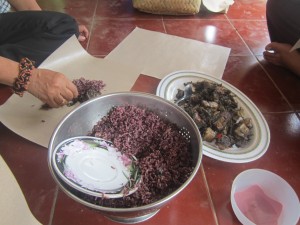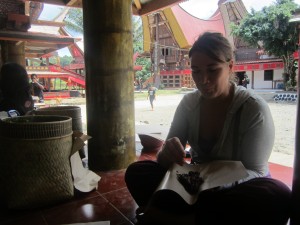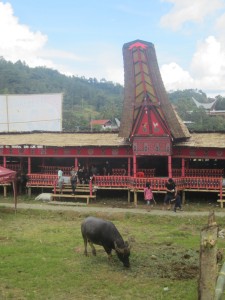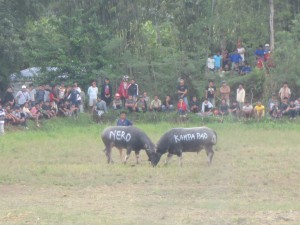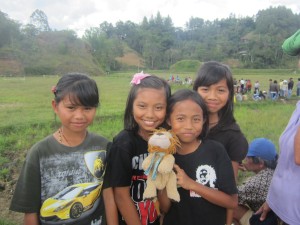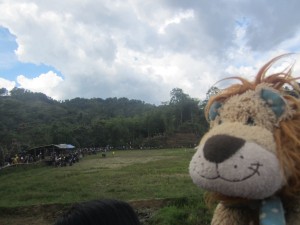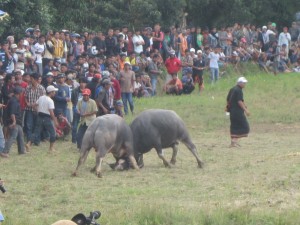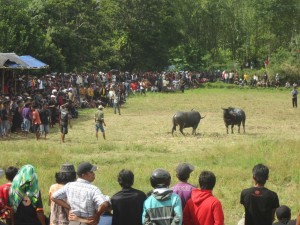Lewis the Lion was keen to explore the town of Tana Toraja in South Sulawesi as he had heard that it was a unique place particularly in the way they buried their dead. Here funeral festivals called ‘Rambu Solo’ could take a few days to celebrate, culminating in the body being buried high up into a cliff face if they are from a notable family.
The first thing that struck Lewis the Lion when he’d arrived in Tana Toraja in his “Formula One” taxi was the number of roofs that were bow-shaped. He couldn’t be sure if they were houses or storehouses but he would do his best to investigate over the coming days.
For all the town of Tana Toraja was perhaps one of Sulawesi’s top tourist attractions, Lewis the Lion quickly realised that without your own transport, you weren’t likely to get anywhere fast here. Hiring a car was out of the question after experiencing how crazy the drivers were over here and even riding a moped sent shivers down his spine. But even if he had wanted to hire a moped, this seemed far to complicated a task for the locals to organise without wanting to charge an extortionate amount. How on earth were he and his friends going to get around?
The answer came in two forms: one, a type of local taxi-bus called a ‘bemo’ to the centre, Makale and then two, riding pillion on the back of motor-taxi called an ‘oject’ to one of the hillside villages.
Higher up the hillside, about 5 kilometres from Makale, the funeral preparations for a notable lady were taking place in the village of Lonnó. So clinging onto the back of the motor-taxi driver, the three friends (Lewis the Lion, Helen and Marion) rode up into the mountains which were surrounded by paddy fields.
It was clear that the person who had died was from an important or powerful family, judging by the number of grain houses near the family home.
Lewis the Lion discovered that both storerooms and ancestoral homes all have the traditional boat-shaped, split-bamboo roofs with ornately, wooden-patterned panels.
These are called Tongkonan and they stand high on wooden stilts allowing you “to sit” underneath them. He noticed that the walls were finely crafted wood carvings and he could see reds, blacks and yellows with swirls, circles, crosses and rooster emblems. He was surprised to discover that this part of Indonesia was mainly Catholic, even though the majority of Indonesia is Muslim.
As Lewis the Lion, Helen and Marion wandered into the area near the ancestoral home of the deceased family member, they were plainly the only tourists in town and they felt a little bit out of place as the villagers all seemed to be just relaxing and hanging out in and around the courtyard. Thankfully though they were soon welcomed by one of the family members, a Dutch gentleman who was married to one of the daughters of the deceased lady. He very kindly took the time to tell the visitors a little more about the funeral preparations here in Tana Toraja.
First of all, he told them that there are usually two funerals for the person who has died. One which is private straight after the death for the family members and then one which is a public affair which is like a huge party. The second funeral is often very expensive and takes a lot of organising. So while the family raise the funds to host the funeral, the body is preserved by wrapping it in several layers of cloth and is then kept in the family home with a constant vigil. Lewis the Lion discovered that the grandmother in question had died in June but the funeral ceremony wasn’t going to take place till the 24th December so that all the dignitaries could attend the ceremony as she was an important lady. In fact, she was so important that the Sultan of South Sulawesi with his wife would be in attendance, along with other dignitaries at the funeral the next day.
Lewis the Lion and his friends were then kindly invited into the family home to pay their respects to the deceased grandmother. She had had 14 children, 8 boys and 6 girls and had had many grandchildren too. It was clear that she had been a much loved lady the way that so many people were gathered together to celebrate her life for her funeral the next day. The Torajans believe that somebody’s life does not end abruptly with death but rather that the soul of the deceased lingers around the village until the funeral ceremony is completed, after which it begins its journey to “Puya” or the afterlife.
When a person dies, the Torajans believe that as they journey to the afterlife or heaven, they are judged on how successful they have been in their life by how many animal spirits accompany them. The most expensive animal around is the water buffalo so many of them get slaughtered during the funeral festival. Lewis the Lion noticed that outside the Tongkonan were the body lay, were already 27 sets of water buffalo horns. In other words, this was the number of water buffaloes that had been slaughtered during the funeral of the deceased lady’s late husband.
They were clearly from a very wealthy and powerful family not only because of the number of grain houses surrounding their traditional home but with so many buffaloes being sacrificed. (The middle classes would normally only kill 8 water buffalo and anything more thann 24 is usually reserved for the royal family or very important families).
Although the main funeral festival would take place in two days’ time, Lewis the Lion was rather glad that he wouldn’t be here to see this mass slaughter, as the sacrifice would take place right outside the house where the body was kept. Today the preliminary celebrations seemed much more light hearted with music and water buffalo betting! From the house he noticed a special miniature style house had been prepared for the pallbearers to carry the coffin as you can see in the photo below.
Outside the house, Lewis the Lion was happy to then listen to some of the women villagers beat out a rhythm using wooden sticks. This funeral music rang out low and loud. This was music was a signal to the village that the afternoon’s entertainment would soon be taking place.
You can click here to see a video clip on You Tube of the ladies as they told the village of the next phase of the funeral festival, as the music rings out across the village.
As the women beat the wood rhythmically, Lewis the Lion delighted in watching an old woman dancing in time to the music. She was thoroughly enjoying herself as she danced with abandonment and a big beam across her face. Click here to see a snippet on You Tube.
A loud speaker then made several announceents in Indonesian which Lewis the Lion couldn’t quite understand but he was told by the family that something special would be happening in one of the lower fields in about half an hour but first he was welcomed to have some lunch with the family.
Sitting underneath one of the grain houses and taking off their shoes, Lewis the Lion and his friends were welcomed to share some food with the bereaved family. Lewis the Lion was sure that the lady who had died would have been very proud of her family as they made the visitors so welcome, sharing with them their rice cooked in banana leaves and pork.
They were invited to eat as much as they liked, eating from a piece of paper with their hands, after which they washed their hands in a bowl of water.
This time one of the deceased lady’s daughters talked to the visitors a bit more about this special ceremony. Even though you could see the sadness behind her eyes over the death of her mother, she told them that this part of the funeral was to be joyous; a time for thanksgiving and celebration. She told them that this traditional ceremony involves Christian aspects but that it is also mixed in with some with traditional local beliefs, such as the body is buried with precious possessions. Lewis the Lion remembered that the Ancient Eygyptians used to do that too!
After lunch, the friends were then invited to go down towards the lower field where big crowds were starting to gather.
Lewis the Lion had already seen that some of the water buffaloes had their names written on their backs in big white lettering but didn’t understand why.
He then learnt that two days prior to the main funeral, the villagers gathered to see the water buffalos locking horns. At first he thought that this sounded a bit barbaric but then he realised that the water buffaloes didn’t actually hurt each other.
The fun came as people placed bets on the water buffalo which they thought would stand his ground for the longest and chase the other buffalo off the field! Big cheers came from the crowd as the two buffaloes chased each other across the fields. There must have been about 300 people enjoying the spectacle.
You can see on this You Tube video a flavour of the afternoon’s entertainment as Lewis the Lion watches the water buffalo competition.
As Lewis the Lion and his friends were intrigued to see what was happening, some of the local children also came to greet him. They were curious to see foreigners all the way up in the mountains here and even more curious to meet a friendly lion!
Lewis the Lion was most impressed with their language learning skills as many of these children were not afraid to have a go at speaking English. He only wished that he spoke a little bit more Indonesian! Very quickly though, their attention was turned to the main event. Lewis the Lion laughed as he saw the buffaloes chase each other across lots of fields with men running after them, trying to get them to slow down.
He couldn’t believe that some of the villagers were standing so close to these great beasts but they obviously wanted to get as close to the drama as possible.
After seeing a dozen or so competeting water buffaloes, Lewis the Lion and his friends decided to head back into the town of Makale, eventually finding another ‘oject’ to take them. They chose the right moment to leave as just then, it started to rain.
What a fascinating afternoon it had been! He realised that death in Tana Toraja wasn’t something to be feared but rather something that was celebrated by the whole village. Of course at this time of year, funeral festivals wasn’t the only thing being celebrated. It was two days before Christmas and around the town fireworks were being sold and posters of politicians bade seasons greetings. Lewis the Lion rather liked this one in particular, as he had met these very people when he had been at the Governor’s house not two days before.
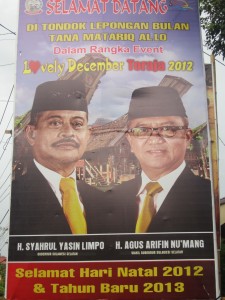
A Merry Christmas 2012 and a Happy New Year 2013 from the Governor and deputy Governor of South Sulawesi
He already felt like he was getting a real taste of the life and culture here in Sulawesi.
Lewis the Lion wants you to imagine that you lived in Tana Toraja.
If you died there what possessions would you like to bring with you into ‘Puya’ or the afterlife?

